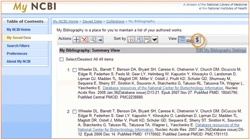Archived: New Blog from NIH Extramural Research Chief
January 25, 2011
Continue Reading
Archived: Changes in NIH Application Policies
October 8, 2010
Continue Reading
Archived: Update: Status of hESC Applications and Grants
September 13, 2010
Continue Reading
Archived: Status of hESC Applications and Grants
September 3, 2010
Continue Reading
Archived: New Distributor for Knockout Mice
August 31, 2010
Continue Reading
Archived: Elimination of Electronic Submission Error Correction Window
August 20, 2010
Continue Reading
Archived: Impact Score Paragraph in Summary Statements, Plain Language in Public Sections of Grant Applications
August 11, 2010
Continue Reading
Archived: Electronic Awards Administration
July 14, 2010
Continue Reading


 NIGMS (and other NIH) investigators previously have been able to obtain over 2,500 knockout mouse strains at a negotiated cost from Lexicon. These mouse strains are no longer available directly through Lexicon.
NIGMS (and other NIH) investigators previously have been able to obtain over 2,500 knockout mouse strains at a negotiated cost from Lexicon. These mouse strains are no longer available directly through Lexicon.
 NIH has announced a significant upgrade to the citation management capability of investigators’ personal profiles in the eRA Commons.
With the integration of the National Center for Biotechnology Information (NCBI) “My Bibliography” portal, direct database queries will replace manual citation entry in the Commons. This will have many benefits, most immediately for your eSNAP progress reports due to more accurate data and automated evaluation of each citation’s Public Access Policy compliance status.
You must now enter citations via My Bibliography accounts. Users (investigators or delegates) will need to have a My NCBI account and link it to their Commons account. Instructions are available on the Commons Web site at https://era.nih.gov/.
Please note that beginning July 23, you will not be able to manually enter a citation directly into the Commons. You will still be able to manually enter citations of publications and other items not indexed in PubMed (book chapters, meeting abstracts, etc.), but this must be done using My Bibliography. Also note that beginning on October 22, all citations that had been manually entered into the Commons will no longer be displayed. Publications abstracted in PubMed will automatically appear in My Bibliography; other citations must be added to My Bibliography to appear.
NIH has announced a significant upgrade to the citation management capability of investigators’ personal profiles in the eRA Commons.
With the integration of the National Center for Biotechnology Information (NCBI) “My Bibliography” portal, direct database queries will replace manual citation entry in the Commons. This will have many benefits, most immediately for your eSNAP progress reports due to more accurate data and automated evaluation of each citation’s Public Access Policy compliance status.
You must now enter citations via My Bibliography accounts. Users (investigators or delegates) will need to have a My NCBI account and link it to their Commons account. Instructions are available on the Commons Web site at https://era.nih.gov/.
Please note that beginning July 23, you will not be able to manually enter a citation directly into the Commons. You will still be able to manually enter citations of publications and other items not indexed in PubMed (book chapters, meeting abstracts, etc.), but this must be done using My Bibliography. Also note that beginning on October 22, all citations that had been manually entered into the Commons will no longer be displayed. Publications abstracted in PubMed will automatically appear in My Bibliography; other citations must be added to My Bibliography to appear.